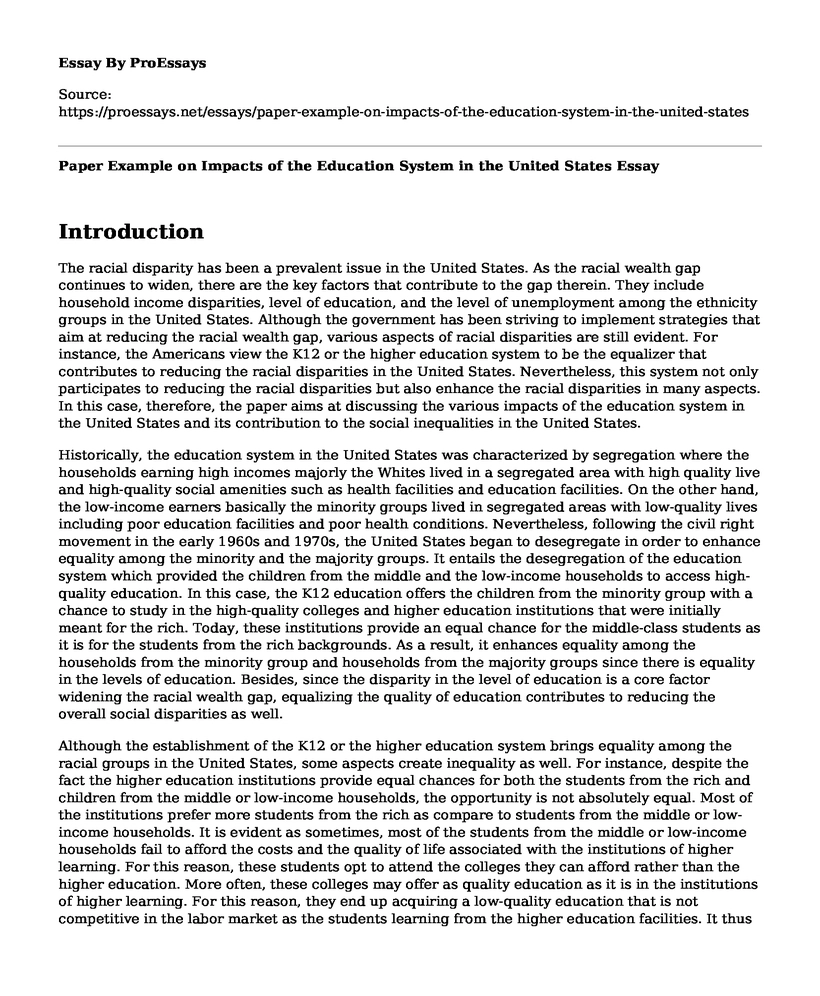Introduction
The racial disparity has been a prevalent issue in the United States. As the racial wealth gap continues to widen, there are the key factors that contribute to the gap therein. They include household income disparities, level of education, and the level of unemployment among the ethnicity groups in the United States. Although the government has been striving to implement strategies that aim at reducing the racial wealth gap, various aspects of racial disparities are still evident. For instance, the Americans view the K12 or the higher education system to be the equalizer that contributes to reducing the racial disparities in the United States. Nevertheless, this system not only participates to reducing the racial disparities but also enhance the racial disparities in many aspects. In this case, therefore, the paper aims at discussing the various impacts of the education system in the United States and its contribution to the social inequalities in the United States.
Historically, the education system in the United States was characterized by segregation where the households earning high incomes majorly the Whites lived in a segregated area with high quality live and high-quality social amenities such as health facilities and education facilities. On the other hand, the low-income earners basically the minority groups lived in segregated areas with low-quality lives including poor education facilities and poor health conditions. Nevertheless, following the civil right movement in the early 1960s and 1970s, the United States began to desegregate in order to enhance equality among the minority and the majority groups. It entails the desegregation of the education system which provided the children from the middle and the low-income households to access high-quality education. In this case, the K12 education offers the children from the minority group with a chance to study in the high-quality colleges and higher education institutions that were initially meant for the rich. Today, these institutions provide an equal chance for the middle-class students as it is for the students from the rich backgrounds. As a result, it enhances equality among the households from the minority group and households from the majority groups since there is equality in the levels of education. Besides, since the disparity in the level of education is a core factor widening the racial wealth gap, equalizing the quality of education contributes to reducing the overall social disparities as well.
Although the establishment of the K12 or the higher education system brings equality among the racial groups in the United States, some aspects create inequality as well. For instance, despite the fact the higher education institutions provide equal chances for both the students from the rich and children from the middle or low-income households, the opportunity is not absolutely equal. Most of the institutions prefer more students from the rich as compare to students from the middle or low-income households. It is evident as sometimes, most of the students from the middle or low-income households fail to afford the costs and the quality of life associated with the institutions of higher learning. For this reason, these students opt to attend the colleges they can afford rather than the higher education. More often, these colleges may offer as quality education as it is in the institutions of higher learning. For this reason, they end up acquiring a low-quality education that is not competitive in the labor market as the students learning from the higher education facilities. It thus creates disparities in the labor market as they tend not to possess the qualifications increasing the level of unemployment among the minority households. Ideally, this contributes to widening the racial wealth gap in the United States rather than acting as an equalizer.
Conclusion
In conclusion, despite the government's continued efforts to bring equality among the Americans, issues of racial disparities persist. More importantly, the K12 education system not only acts as an equalizer in various aspects but also contributes in creating the racial disparities among the racial groups in the United States as well.
Cite this page
Paper Example on Impacts of the Education System in the United States. (2022, Jul 04). Retrieved from https://proessays.net/essays/paper-example-on-impacts-of-the-education-system-in-the-united-states
If you are the original author of this essay and no longer wish to have it published on the ProEssays website, please click below to request its removal:
- Should the United States Bid to Host a Future Olympic Games?
- Evolution in the Court's Jurisprudence in Canada: Law Essay Sample
- The Implementation of Transformational Leadership in UAE International Schools to Increase Boys' Academic Achievements
- Essay on Personal Learning Style
- Public School System and Academic Success Essay Example
- Paper Example on Learning Language: A Key to Understanding Culture and Self
- Free Essay Example on Unlocking the Fascinating World of Nurse Anesthesia







